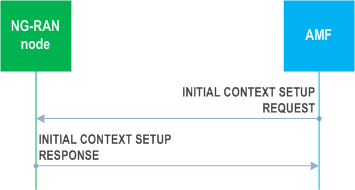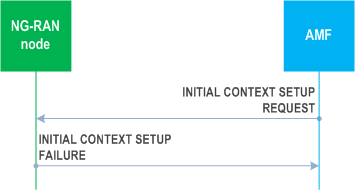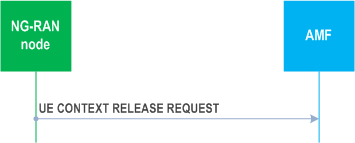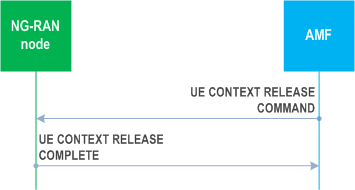Content for TS 38.413 Word version: 18.2.0
1…
4…
8…
8.2…
8.2.3…
8.3…
8.3.4…
8.4…
8.4.3…
8.5…
8.7…
8.8…
8.10…
8.12…
8.17…
9…
9.2…
9.2.2…
9.2.3…
9.2.4…
9.2.6…
9.2.7…
9.2.9…
9.2.11…
9.2.16…
9.2.17…
9.3…
9.3.1.21…
9.3.1.41…
9.3.1.61…
9.3.1.81…
9.3.1.101…
9.3.1.121…
9.3.1.141…
9.3.1.161…
9.3.1.181…
9.3.1.205…
9.3.1.222…
9.3.1.245…
9.3.2…
9.3.3…
9.3.3.21…
9.3.3.42…
9.3.4…
9.3.4.10…
9.3.5…
9.4…
9.4.4
9.4.5
9.4.6…
9.5…
10…
8.3 UE Context Management Procedures
8.3.1 Initial Context Setup
8.3.1.1 General
8.3.1.2 Successful Operation
8.3.1.3 Unsuccessful Operation
8.3.1.4 Abnormal Conditions
8.3.2 UE Context Release Request (NG-RAN node initiated)
8.3.2.1 General
8.3.2.2 Successful Operation
8.3.2.3 Abnormal Conditions
8.3.3 UE Context Release (AMF initiated)
8.3.3.1 General
8.3.3.2 Successful Operation
8.3.3.3 Unsuccessful Operation
8.3.3.4 Abnormal Conditions
...
...
8.3 UE Context Management Procedures p. 44
8.3.1 Initial Context Setup p. 44
8.3.1.1 General p. 44
The purpose of the Initial Context Setup procedure is to establish the necessary overall initial UE context at the NG-RAN node, when required, including PDU session context, the Security Key, Mobility Restriction List, UE Radio Capability and UE Security Capabilities, etc. The AMF may initiate the Initial Context Setup procedure if a UE-associated logical NG-connection exists for the UE or if the AMF has received the RAN UE NGAP ID IE in an INITIAL UE MESSAGE message or if the NG-RAN node has already initiated a UE-associated logical NG-connection by sending an INITIAL UE MESSAGE message via another NG interface instance. The procedure uses UE-associated signalling.
For signalling only connections and if the UE Context Request IE is not received in the Initial UE Message, the AMF may be configured to trigger the procedure for all NAS procedures or on a per NAS procedure basis depending on operator's configuration.
8.3.1.2 Successful Operation p. 44

In case of the establishment of a PDU session the 5GC shall be prepared to receive user data before the INITIAL CONTEXT SETUP RESPONSE message has been received by the AMF. If no UE-associated logical NG-connection exists, the UE-associated logical NG-connection shall be established at reception of the INITIAL CONTEXT SETUP REQUEST message.
The INITIAL CONTEXT SETUP REQUEST message shall contain the Index to RAT/Frequency Selection Priority IE, if available in the AMF.
If the NAS-PDU IE is included in the INITIAL CONTEXT SETUP REQUEST message, the NG-RAN node shall pass it transparently towards the UE.
If the Masked IMEISV IE is contained in the INITIAL CONTEXT SETUP REQUEST message the target NG-RAN node shall, if supported, use it to determine the characteristics of the UE for subsequent handling.
Upon receipt of the INITIAL CONTEXT SETUP REQUEST message the NG-RAN node shall
- attempt to execute the requested PDU session configuration;
- store the received UE Aggregate Maximum Bit Rate in the UE context, and use the received UE Aggregate Maximum Bit Rate for Non-GBR QoS flows for the concerned UE as specified in TS 23.501;
- store the received Mobility Restriction List in the UE context;
- store the received UE Radio Capability in the UE context;
- store the received Index to RAT/Frequency Selection Priority in the UE context and use it as defined in TS 23.501;
- store the received UE Security Capabilities in the UE context;
- store the received Security Key in the UE context and, if the NG-RAN node is required to activate security for the UE, take this security key into use;
- if supported, store the received SRVCC Operation Possible in the UE context and use it as defined in TS 23.216;
- store the received NR V2X Services Authorization information, if supported, in the UE context;
- store the received LTE V2X Services Authorization information, if supported, in the UE context;
- store the received NR A2X Services Authorization information, if supported, in the UE context;
- store the received LTE A2X Services Authorization information, if supported, in the UE context;
- store the received NR UE Sidelink Aggregate Maximum Bit Rate, if supported, in the UE context, and use it for the concerned UE's sidelink communication in network scheduled mode for NR V2X services;
- store the received LTE UE Sidelink Aggregate Maximum Bit Rate, if supported, in the UE context, and use it for the concerned UE's sidelink communication in network scheduled mode for LTE V2X services;
- store the received NR A2X UE PC5 Aggregate Maximum Bit Rate, if supported, in the UE context, and use it for the concerned UE's sidelink communication in network scheduled mode for NR A2X services;
- store the received LTE A2X UE PC5 Aggregate Maximum Bit Rate, if supported, in the UE context, and use it for the concerned UE's sidelink communication in network scheduled mode for LTE A2X services;
- store the received PC5 QoS Parameters, if supported, in the UE context and use it as defined in TS 23.287;
- store the received A2X PC5 QoS Parameters, if supported, in the UE context and use it as defined in TS 23.256.
- store the received Management Based MDT PLMN List information, if supported, in the UE context;
- if supported, store the received IAB Authorization information in the UE context, and use it accordingly for the IAB-MT as specified in TS 38.401;
- store the received 5G ProSe Authorization information in the UE context, if supported, and use it for the concerned UE's sidelink communication in network scheduled mode for 5G ProSe services;
- store the received 5G ProSe UE PC5 Aggregate Maximum Bit Rate in the UE context, if supported, and use it for the concerned UE's sidelink communication in network scheduled mode for 5G ProSe services;
- store the received 5G ProSe PC5 QoS Parameters, if supported, in the UE context and use it as defined in TS 23.304;
- store the received Ranging and Sidelink Positioning service information, if supported, in the UE context;
- store the received Network Controlled Repeater Authorization, if supported, in the UE context;
- if supported, store the received Mobile IAB Authorization information in the UE context, and use it accordingly for the mobile IAB-MT;
- store the received PDU Set QoS parameters, if supported, in the UE context and use it as specified in TS 23.501.
- determine a target for subsequent mobility action for which the NG-RAN node provides information about the target of the mobility action towards the UE;
- select a proper SCG during dual connectivity operation;
- assign proper RNA(s) for the UE when moving the UE to RRC_INACTIVE state.
- one of the QoS flows includes a particular ARP value (TS 23.501).
- if the Trace Activation IE includes the MDT Activation IE set to "Immediate MDT and Trace", initiate the requested trace session and MDT session as described in TS 32.422;
- if the Trace Activation IE includes the MDT Activation IE set to "Immediate MDT Only", "Logged MDT only", initiate the requested MDT session as described in TS 32.422 and the NG-RAN node shall ignore the Interfaces To Trace IE and the Trace Depth IE;
- if the Trace Activation IE includes the MDT Location Information IE within the MDT Configuration IE, store this information and take it into account in the requested MDT session;
- if the Trace Activation IE includes the Signalling Based MDT PLMN List IE within the MDT Configuration IE, the NG-RAN node may use it to propagate the MDT Configuration as described in TS 37.320.
- if the Trace Activation IE includes the Bluetooth Measurement Configuration IE within the MDT Configuration IE, take it into account for MDT Configuration as described in TS 37.320.
- if the Trace Activation IE includes the WLAN Measurement Configuration IE within the MDT Configuration IE, take it into account for MDT Configuration as described in TS 37.320.
- if the Trace Activation IE includes the Sensor Measurement Configuration IE within the MDT Configuration IE, take it into account for MDT Configuration as described in TS 37.320.
- if the Trace Activation IE includes the MDT Configuration IE and if the NG-RAN node is a gNB at least the MDT Configuration-NR IE shall be present, while if the NG-RAN node is an ng-eNB at least the MDT Configuration-EUTRA IE shall be present.
- if the Trace Activation IE includes the MN Only MDT Collection IE and the MN Only MDT Collection IE is set to "MN only", consider that the MDT Configuration-NR IE or the MDT Configuration-EUTRA IE is only applicable for the MN if the UE is configured with MR-DC.
The NG-RAN node shall use the AMF UE NGAP ID IE and RAN UE NGAP ID IE received in the INITIAL CONTEXT SETUP REQUEST message as identification of the logical connection even if the RAN UE NGAP ID IE had been allocated in an INITIAL UE MESSAGE message sent over a different NG interface instance.
Interactions with RRC Inactive Transition Report procedure:
If the RRC Inactive Transition Report Request IE is included in the INITIAL CONTEXT SETUP REQUEST message and set to "subsequent state transition report", the NG-RAN node shall, if supported, send the RRC INACTIVE TRANSITION REPORT message to the AMF to report the RRC state of the UE when the UE enters or leaves RRC_INACTIVE state.
8.3.1.3 Unsuccessful Operation p. 48

If the NG-RAN node is not able to establish an NG UE context, it shall consider the procedure as failed and reply with the INITIAL CONTEXT SETUP FAILURE message.
If the PDU Session Resource Setup Request List IE is contained in the INITIAL CONTEXT SETUP REQUEST message, the NG-RAN node shall report to the AMF, in the INITIAL CONTEXT SETUP FAILURE message, the unsuccessful establishment result for each PDU session resource requested to be setup as defined in the PDU Session Resource Setup procedure.
Upon reception of the INITIAL CONTEXT SETUP FAILURE message the AMF shall, for each PDU session indicated in the PDU Session ID IE, transfer transparently the PDU Session Resource Setup Unsuccessful Transfer IE to the SMF associated with the concerned PDU session and may consider that the NAS PDU included in the INITIAL CONTEXT SETUP REQUEST message was not delivered.
8.3.1.4 Abnormal Conditions p. 49
If the supported algorithms for encryption defined in the Encryption Algorithms IE in the UE Security Capabilities IE, plus the mandated support of EEA0 and NEA0 in all UEs (TS 33.501), do not match any allowed algorithms defined in the configured list of allowed encryption algorithms in the NG-RAN node (TS 33.501), the NG-RAN node shall reject the procedure using the INITIAL CONTEXT SETUP FAILURE message.
If the Partially Allowed NSSAI IE is received in the INITIAL CONTEXT SETUP REQUEST message and the total number of S-NSSAIs included in the Allowed NSSAI and Partially Allowed NSSAI exceeds eight, the NG-RAN node shall consider the procedure as failed.
If any of the S-NSSAI which is present in the Partially Allowed NSSAI IE is also present in the Allowed NSSAI IE, the NG-RAN node shall consider the procedure as failed.
If the supported algorithms for integrity defined in the Integrity Protection Algorithms IE in the UE Security Capabilities IE, plus the mandated support of the EIA0 and NIA0 algorithm in all UEs (TS 33.501), do not match any allowed algorithms defined in the configured list of allowed integrity protection algorithms in the NG-RAN node (TS 33.501), the NG-RAN node shall reject the procedure using the INITIAL CONTEXT SETUP FAILURE message.
If the PNI-NPN Area Scope of MDT IE is included in the MDT Configuration-NR IE in the INITIAL CONTEXT SETUP REQUEST message, and the Area Scope of MDT IE is set to "PNI-NPN Based MDT", the NG-RAN node shall, if supported, use the Area Scope of MDT IE to derive the MDT area scope for MDT measurement collection in PNI-NPN areas, and ignore the PNI-NPN Area Scope of MDT.
8.3.2 UE Context Release Request (NG-RAN node initiated) p. 49
8.3.2.1 General p. 49
The purpose of the UE Context Release Request procedure is to enable the NG-RAN node to request the AMF to release the UE-associated logical NG-connection due to NG-RAN node generated reasons. The procedure uses UE-associated signalling.
8.3.2.2 Successful Operation p. 49

The NG-RAN node controlling a UE-associated logical NG-connection initiates the procedure by sending a UE CONTEXT RELEASE REQUEST message towards the affected AMF.
The UE CONTEXT RELEASE REQUEST message shall indicate the appropriate cause value, e.g., "TXnRELOCOverall Expiry", "Redirection", for the requested UE-associated logical NG-connection release.
If the PDU Session Resource List IE is included in the UE CONTEXT RELEASE REQUEST message, the AMF shall handle this information as specified in TS 23.502.
Interactions with UE Context Release procedure:
The UE Context Release procedure should be initiated upon reception of a UE CONTEXT RELEASE REQUEST message with the Cause IE set to a value different than "User inactivity". The UE Context Release procedure should be initiated upon reception of a UE CONTEXT RELEASE REQUEST message with the Cause IE set to "User inactivity" and there is no downlink signaling, as specified in TS 23.502. If the UE was configured with DC radio resources at the time UE Context Release Request procedure was triggered, and the PSCell information was available, the NG-RAN node shall store the PSCell information in the UE context.
8.3.2.3 Abnormal Conditions p. 50
Void.
8.3.3 UE Context Release (AMF initiated) p. 50
8.3.3.1 General p. 50
The purpose of the UE Context Release procedure is to enable the AMF to order the release of the UE-associated logical NG-connection due to various reasons, e.g., completion of a transaction between the UE and the 5GC, or release of the old UE-associated logical NG-connection when the UE has initiated the establishment of a new UE-associated logical NG-connection, etc. The procedure uses UE-associated signalling.
8.3.3.2 Successful Operation p. 50

The AMF initiates the procedure by sending the UE CONTEXT RELEASE COMMAND message to the NG-RAN node.
The UE CONTEXT RELEASE COMMAND message shall contain both the AMF UE NGAP ID IE and the RAN UE NGAP ID IE if available, otherwise the message shall contain the AMF UE NGAP ID IE.
Upon reception of the UE CONTEXT RELEASE COMMAND message, the NG-RAN node shall release all related signalling and user data transport resources and reply with the UE CONTEXT RELEASE COMPLETE message.
If the PDU Session Resource List IE is included in the UE CONTEXT RELEASE COMPLETE message, the AMF shall handle this information as specified in TS 23.502.
If the User Location Information IE is included in the UE CONTEXT RELEASE COMPLETE message, the AMF shall handle this information as specified in TS 23.502.
If the Information on Recommended Cells and RAN Nodes for Paging IE is included in the UE CONTEXT RELEASE COMPLETE message, the AMF shall, if supported, store it and may use it for subsequent paging.
For each PDU session for which the Secondary RAT Usage Information IE is included in the PDU Session Resource Release Response Transfer IE, the SMF shall handle this information as specified in TS 23.502.
If the Paging Assistance Data for CE Capable UE IE is included in the UE CONTEXT RELEASE COMPLETE message, the AMF shall, if supported, store it and use it for subsequent paging, as specified in TS 23.502.
8.3.3.3 Unsuccessful Operation p. 51
Not applicable.
8.3.3.4 Abnormal Conditions p. 51
If the UE Context Release procedure is not initiated towards the NG-RAN node before the expiry of the timer TNGRELOCOverall, the NG-RAN node shall request the AMF to release the UE context.
If the UE returns to the NG-RAN node before the reception of the UE CONTEXT RELEASE COMMAND message or the expiry of the timer TNGRELOCOverall, the NG-RAN node shall stop the timer TNGRELOCOverall and continue to serve the UE.